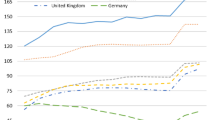Abstract
The author shows that there is a limit in economy at which the rate of growth of GDP becomes less than the rate of growth of welfare; and to maintain current welfare, the population decreases by birth rate decrease. In post-industrial economies, the welfare of population is retained and grows due to budget deficit paid off by borrowing. Under the conditions of the world economic crisis lasting since 2008, hasty growth of debt service payments with the retention of welfare of the population will result in bankruptcy of post-industrial economies.
Similar content being viewed by others
References
O. Blanchard and G. Illing, “Makroökonomie,” Pearson Education, 8, 313 (2009).
L. W. Erhard, Prosperity for All [in German], Econ-Verlag, Düsseldorf (1957).
The History of World Economic Crises: Reference," RIA NOVOSTI, 9/17/2006, http://ria.ru/crisis_spravki/20080917/151357556.html#ixzz3CjvntPZ2.
B. B. Dunaev, “The rate of growth of wage rate as a function of unemployment rate,” Cybern. Syst. Analysis, 47, No. 5, 791–799 (2011).
B. B. Dunaev, Wellbeing — Labor, Capital, and Money: Fundamentals of the Theory of Reproduction [in Russian], PPNV, Kyiv (2005).
B. B. Dunaev, “Dynamics of public debt management,” Cybern. Syst. Analysis, 49, No. 6, 865–876 (2013).
B. B. Dunaev, “Monetary control of economic equilibrium,” Cybern. Syst. Analysis, 48, No. 2, 205–216 (2012).
World Economic and Social Survey 2009: Promoting Development, Saving the Planet, United Nations Economic and Social Council (2009), http://www.un.org/en/development/desa/policy/wess/wess_archive/2009wess.pdf
B. B. Dunaev, “Optimizing the growth of real gross domestic product,” Cybern. Syst. Analysis, 49, No. 1, 98–109 (2013).
“Eurostat: Quarter of the European population are on the brink of poverty,” Newzz.in.ua, December 10 (2013), http://newzz.in.ua/economic/1148906020-evrostat-chetvert-zhiteley-evropy-nahodyatsya-na-grani-nischety.html.
B. B. Dunaev, “Calculating gross domestic product as a function of labor and capital,” Cybern. Syst. Analysis, 40, No. 1, 86–96 (2004).
B. B. Dunaev, “Macroeconomic model of reproduction,” Cybern. Syst. Analysis, 41, No. 6, 879–890 (2005).
B. B. Dunaev, “Macroeconomic governmental regulation and self-regulation of market equilibrium,” Cybern. Syst. Analysis, 42, No. 5, 702–713 (2006).
B. B. Dunaev, “Money supply and interest rate in economics equilibrium,” Cybern. Syst. Analysis, 46, No. 1, 115–128 (2010).
J. D. Sachs and F. B. Larrain, Macroeconomics in the Global Economy, Prentice Hall (1993).
J. C. Chesnais, The Demographic Transition: Stages, Patterns, and Economic Implications, Clarendon Press, Oxford (1992).
W. Lutz, The Future Population of the World: What Can We Assume Today? Earthscan, London (1996).
D. McLaren, “Population growth — should we be worried?” Population and Environment, 17, No. 3, 243–259 (1996).
S. P. Kapitsa, The General Theory of Growth of the Mankind: How Many People Lived, Live, and Will Live on the Earth [in Russian], Nauka, Moscow (1999).
Bulletin of the National Bank of Ukraine, No. 1–12 (140–151) (2006).
Bulletin of the National Bank of Ukraine, No. 1–12 (202–213) (2010).
Bulletin of the National Bank of Ukraine, No. 1–10 (238–247) (2013).
Statistical Yearbook of Ukraine for 2010 [in Ukrainian], Avgust Treid, Kyiv (2011).
A. G. Volkov, R. M. Dmitriev, Zh. A. Zajonchkovskaya, et al., Population of the USSR: A Reference Book [in Russian], Politizdat, Moscow (1983).
National Accounts of Ukraine for 2010, Derzh. Komitet Statistiki Ukrainy, Kyiv (2012).
The State and Guaranteed State Debt of Ukraine, May 14 (2012), http://www.minfin.gov.ua/control/uk/publish/.
Author information
Authors and Affiliations
Corresponding author
Additional information
Translated from Kibernetika i Sistemnyi Analiz, No. 2, March–April, 2015, pp. 151–163.
Rights and permissions
About this article
Cite this article
Dunaev, B.B. Dynamics of Welfare of the Population of a Country. Cybern Syst Anal 51, 291–302 (2015). https://doi.org/10.1007/s10559-015-9721-1
Received:
Published:
Issue Date:
DOI: https://doi.org/10.1007/s10559-015-9721-1




